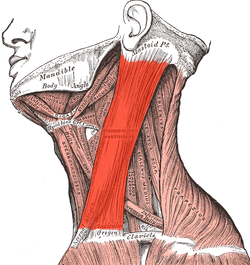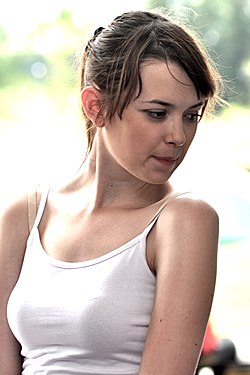Sterno-mastoid
| Sternocleidomastoid | |
|---|---|

Neck muscles, with the sternocleidomastoid shaded.
|
|

The sternocleidomastoid (right muscle shown) can be clearly observed when rotating the head.
|
|
| Details | |
| Pronunciation | (/ˌstɜːrnoʊˌklaɪdəˈmæsˌtɔɪd, -nə-, -doʊ-/) |
| Origin | Manubrium and medial portion of the clavicle |
| Insertion | Mastoid process of the temporal bone, superior nuchal line |
| Artery | Occipital artery and the superior thyroid artery |
| Nerve | Motor: spinal accessory nerve sensory: cervical plexus Proprioceptive: C2,C3 of ventral rami |
| Actions |
Unilaterally: contralateral cervical rotation, ipsilateral cervical flexion Bilaterally: cervical flexion, elevation of sternum and assists in forced inhalation. |
| Identifiers | |
| Latin | Musculus sternocleidomastoideus |
| TA | A04.2.01.008 |
| FMA | 13407 |
|
Anatomical terms of muscle
[]
|
|
Unilaterally: contralateral cervical rotation, ipsilateral cervical flexion
The sternocleidomastoid muscle (also known as sternomastoid, commonly abbreviated as SCM or simply referred to as sterno muscle), is a paired muscle in the superficial layers of the side of the neck. It is one of the largest and most superficial cervical muscles. The primary actions of the muscle are rotation of the head to the opposite side and flexion of the neck. The sternocleidomastoid is innervated by the accessory nerve.
It is given the name sternocleidomastoid because it originates at the manubrium of the sternum (sterno-) and the clavicle (cleido-), and has an insertion at the mastoid process of the temporal bone of the skull.
The sternocleidomastoid originates from two locations: the manubrium of the sternum and the clavicle. It travels obliquely across the side of the neck and inserts at the mastoid process of the temporal bone of the skull. The sternocleidomastoid is thick and narrow at its centre, and broader and thinner at either end.
The sternal head is a round fasciculus, tendinous in front, fleshy behind, arising from the upper part of the front of the manubrium sterni. It travels superiorly, laterally, and posteriorly.
The clavicular head is composed of fleshy and aponeurotic fibers, arises from the upper, frontal surface of the medial third of the clavicle; it is directed almost vertically upward.
...
Wikipedia
